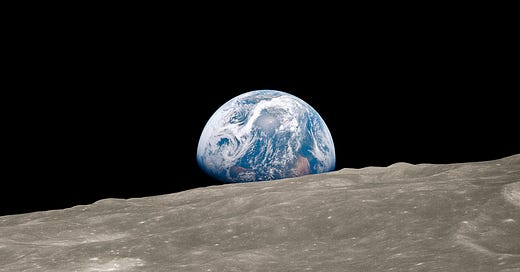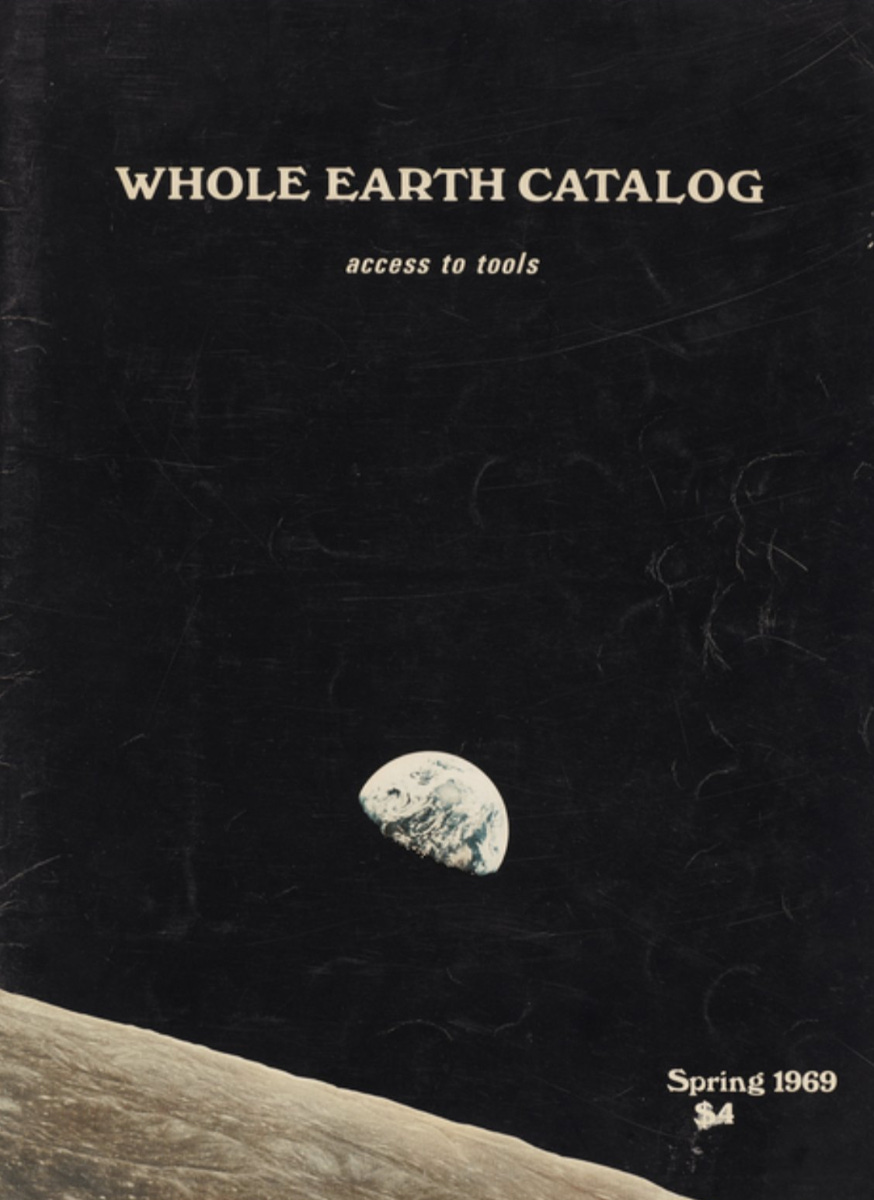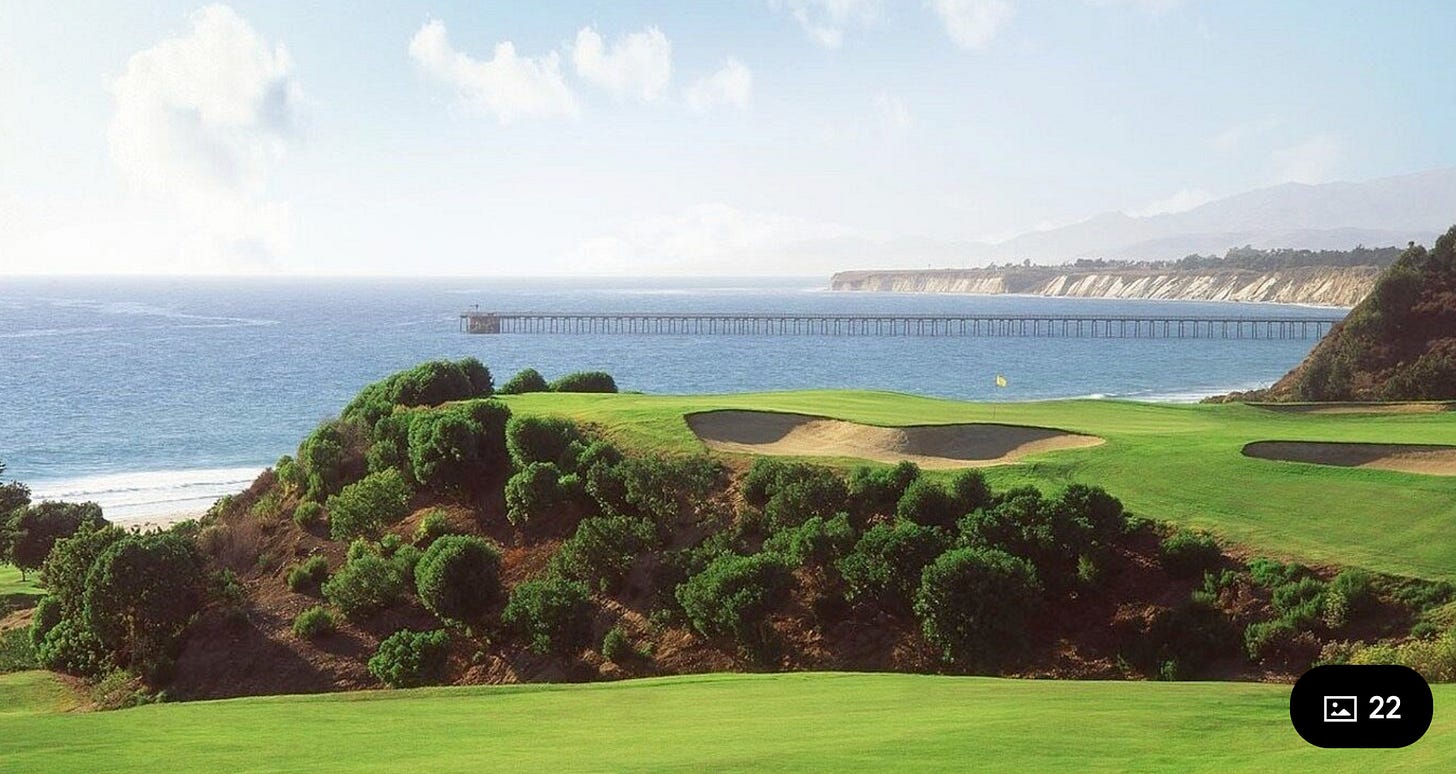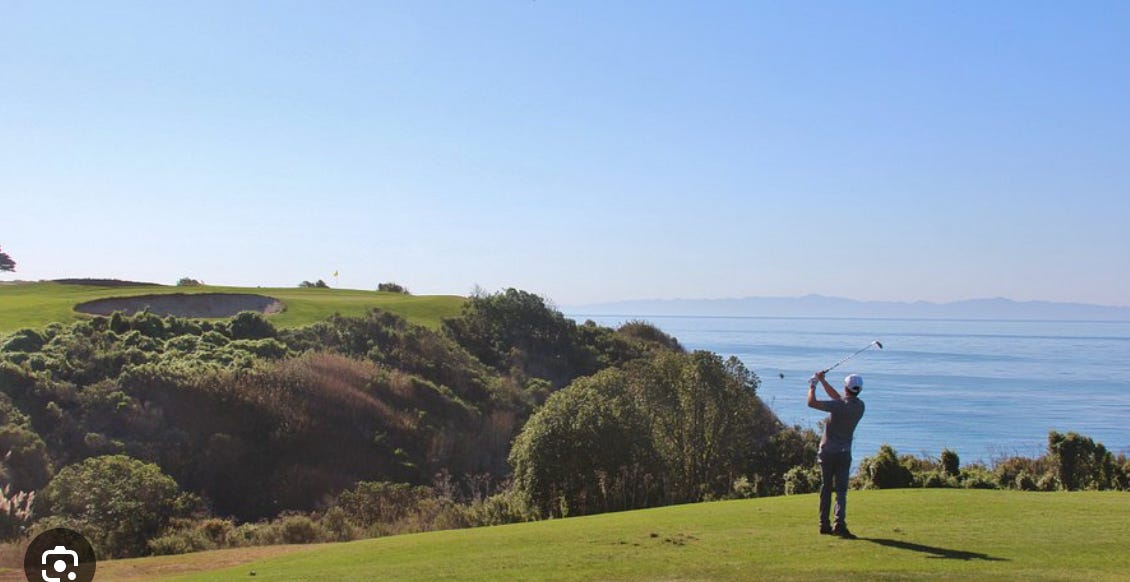Un-Abundance: Why Democrats lost interest in progress in 1969
Abundance would mean middle class guys could plays oceanside golf courses at least once in their life.
The beginning of the Environmental Era is traditionally dated to Christmas Eve, 1968, when Apollo 8 astronaut Bill Anders snapped a number of photos with his Hasselblad camera of the lovely Earth rising over the dead surface moon.
This type of picture from deep space of Earth as a gorgeous orb of life to be cherished and preserved in the terrifyingly vast lifelessness of the universe gave promoter Stewart Brand the name for his hippie/techie magnum opus, the Whole Earth Catalog:
Brand had first dreamed up the idea during a 1966 acid trip in San Francisco, before many deep space photos had been published: “Seeing Earth from space would transform the way we view our planet and ourselves.” So, when the Apollo 8 photos were published back on earth on December 30, 1968, Brand was ready to explain the meaning of it all.
Brand was an extraordinary huckster, but, still he seems to have nailed the sudden change in the zeitgeist with uncanny precision, from the space-bound explorers to Earth-bound conservationists, from rockets to computers.
It’s not unreasonable to say that the Environmental Age started during a few weeks from December 1968 to January 1969. I was only ten, but I can recall the novel furor in late January 1969 over the Santa Barbara oil spill. Before then, anybody who could remember the Depression tended to reflexively assent to any project involving hardhats, bulldozers, and drilling as being “good for the economy.” An occasional oil spill was the price you had to pay for progress.
But in January 1969, the burghers of Santa Barbara suddenly asked themselves, “Hey, wait a minute, the economy is pretty good already, especially here in Santa Barbara. What do we need this for?”
Soon, the Santa Barbara attitude was sweeping the country, starting in coastal California. For example, the people of Beverly Hills had not protested in 1966 the massive construction entailed by Dean Martin’s Beverly Hills Country Club, which required bulldozing multiple ridges in the Hollywood Hills into the canyons to create enough land level enough for a golf ball to stop rolling. But by 1969 the demands by the Teamsters-funded project for more access roads, not to mention the shadowy involvement of characters with names like Ice-Pick Willie based out of Philly led the good folks of Beverly Hills to rebel and shut down the huge project. Why did they need a mobbed-up construction site? Did Beverly Hills really need more building? Think of the ecology! Let’s be progressive and keep things just the way they were when we moved to Beverly Hills.
That’s all background for what I really want to talk about, which are the current plans to renovate the oceanfront Sandpiper Golf Club near the U. of California, Santa Barbara.
The Sandpiper public daily fee golf course is a weird transitional relic between the two ages. It opened in 1972 on the Ellwood oil field about ten miles west of Santa Barbara in Goleta, CA, which had been shelled by a Japanese submarine in February 1942 in a rare attack on the 48 states, as re-imagined in Steven Spielberg’s worst movie:
Stylistically, this Billy Bell Jr. course is a pretty ho-hum post-WWII modernist entity, similar to his more famous coastal Torrey Pines courses in La Jolla, site of a limping Tiger Woods’ most dramatic US Open triumph in 2008.
Still, Sandpiper has a mile of ocean cliff frontage only 108 miles northwest of Los Angeles City Hall.
Golf course design peaked in the Robber Baron era of the 1910s-1920s, when oceanside courses like Pebble Beach and Cypress Point were built, then bottomed out along with building architecture after WWII. The rise of environmentalism from 1969 onward has meant that it’s far more difficult to get golf courses built, but that the few that get built tend to be better but also extremely expensive.
Sandpiper is the kind of post-WWII Good for the Economy golf course that still got built.
It has three excellent holes, the 10th out along a ridge doglegging left toward the sea:
the 11th playing from the cliff down to the beach:
Granted, the 11th isn’t the best imaginable cliff to beach hole, but it’s still a cliff to beach hole.
After the eat-your-vegetables 12th getting you back up the cliff, there’s the cliffside par 5 13th:
Here’ a video:
But then the 14th hole is the worst imaginable clifftop 444 yard par 4: uphill and sloping from the cliff down toward inland, so the ocean is hardly visible.
And then Sandpiper returns inland for the last four holes, ending with a par 3 over an artificial lake. Uh-oh.
In the 1990s, the outstanding design team of famous golfer Ben Crenshaw and brilliant golf architect Bill Coore spent a decade trying to get approval for a much better design on a similar oceanfront property a mile northwest of Sandpiper, ARCO’s Dos Pueblos land.
This would have been a much better golf course than Sandpiper. But the California Coastal Commission shut it down in 2003 for reasons.
Similarly, the idea that Sandpiper isn’t the perfect design for its sensational piece of land has been around since it was opened. I can recall mailing a map of my redesign of the golf course to the management around 1976, while also offering to camp out on the property to photograph it properly. Evidently, they got serious about renovating the golf course around 2003, but it’s not 2025 and maybe something will happen:
Here’s Tom Doak’s current redesign
which is pretty minor in terms of routing: the par 5 13th is turned into a clifftop par 4 and then a par 3 across the arroyo, while the par 4 14th is reversed to play downhill as the par 4 17th. That’s sensible but minor.
Doak is much better at micro-changes around the green, but I care much more about macro-changes in routing.
We live in an age of minoritarianism, so the fact that only about 10% of the population cares about good golf course architecture would seem like a reason to protect it.
But instead, nobody cares.











What a grand year 1969 was. Funny that the left wasn't much interested in environmentalism until 1969. It was the year of the Santa Barbara oil spill and those photos of birds dying in oil. Planet of the Apes had come out the year before forewarning the ecological suicide of the Earth. The long forgotten duo of Zager and Evans came out with the song "2525" in 1969, a song about Earth's dystopian future. Charles Reich came out with the book "The Greening of America" a year later. Another event was the presidency of Richard Nixon began in 1969 just in time for the left to get all sour on America.
I’m writing this comment from Pinehurst,NC this morning where I suspect more than 10% of the population cares about course design. Nature put lots of sand and gentle hills here which made it an easy place to build golf courses back when shovels and humans worked alongside mechanical excavation equipment.
The courses here lack the beauty of seaside views or the drama that comes with elevated tees, but they often have the natural flow from tee to green that is characteristic of the older seaside links courses of Scotland and Ireland, where you didn’t need much “design” to create the course. Out and back was a given, otherwise you were messing with land that mattered to the village or some farmers. Sheep helped keep the fairways trimmed.
There are still a few folks here who think golf was meant for walking, not riding in a cart with GPS and a screen to deliver advertising. We will soon be gone, and the spare moments between swings can be fully monetised.